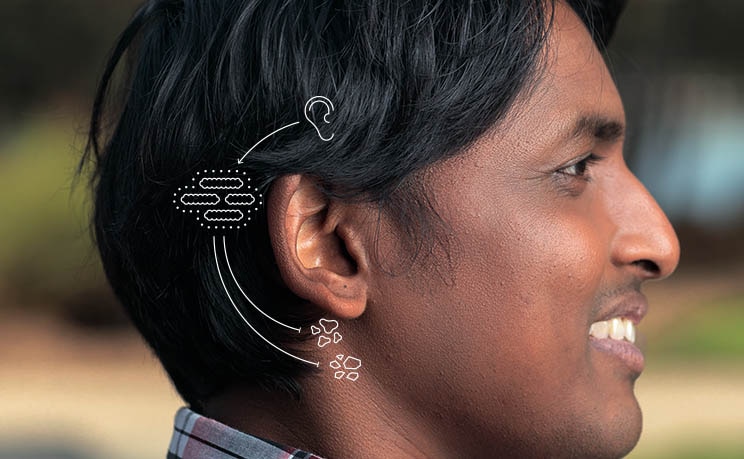AncestryDNA® Traits
Earwax Type
Everyone has earwax. Technically, it's not really "wax." Instead, it's a combination of dead skin cells, hair, oil, sweat, and other secretions. Which type of earwax you have—wet or dry—is entirely determined by your genes. An AncestryDNA® + Traits test can tell you which type your DNA indicates you're most likely to have.

Dry Earwax and Wet Earwax
The two main types of earwax are dry and wet. Dry earwax is flaky and gray or tan. Wet earwax is sticky and yellow or brown. Dry earwax doesn't have cerumen, a waxy substance.
Your earwax type is linked to your origins. Dry earwax first appeared in Asia and is thus more common among Asian and Native American populations. Wet earwax is common among most other populations.
Scientists still aren't sure why Asian and Native American populations' earwax is different from the rest of the world's. One theory is that drier earwax could've been an advantage to ancient populations in the frigid climates of northeast Eurasia.
The Inheritance of Earwax Types
Genetics can explain why you have a certain earwax type. Ancestry scientists can predict what kind of earwax you have by looking at 179 DNA markers associated with the trait.
One marker in the ABCC11 gene seems to have an especially large role in determining whether you have wet or dry earwax.
There are two versions—or genotypes—of the gene: one codes for wet earwax, and the other codes for dry. Wet earwax tends to be the dominant trait, and dry is recessive. That means if you get a "wet" version of the ABCC11 from either your mom or dad, you'll probably have wet earwax.
Scientists think the dry earwax type became common in the ethnicities of ancient northeast Eurasia and then spread to those of East Asia and the Americas.
The Biology of Earwax Type
The main purpose of earwax is to protect your ears—to serve as blockage for things like dirt from getting inside of them. It can fight infections because it has antibacterial and antifungal properties. And earwax also lubricates your ears to keep them from feeling itchy and dry.
Scientists don't know exactly why there are two earwax types. It's possible that having fewer body secretions, like wet earwax, that could freeze made it easier for people to survive in cold climates. So the dry type of earwax became more common in areas with colder climates.
Most likely dry earwax appeared because of a mutation and spread as ancient populations migrated to other parts of the world.
Interesting Facts About Earwax
The same gene that controls earwax type also plays a role in a person's underarm odor.
It's possible to diagnose maple syrup urine disease, which is a rare genetic disorder, by the smell of earwax. It has an unusual maple syrup smell.
Your outer ear canal is constantly making new earwax. But if you try to clean your ear with cotton swabs, you may push the earwax back and block the ear canal. This is especially true for those who have wet earwax. The good news is your ears are generally self-cleaning and don’t need cotton swabs.
It is possible to have too much earwax buildup in your ears, which can lead to hearing loss. For those cases where earwax blocks the ear canal, wax removal can be done through a micro-suction treatment administered in a doctor’s office.
References
Balter, Michael. "You've got what in your ears?" Science Magazine. January 30, 2006. https://www.sciencemag.org/news/2006/01/youve-got-what-your-ears.
Engelhaupt, Erika. "What your earwax says about your ancestry." Science News. February 24, 2014. https://www.sciencenews.org/blog/gory-details/what-your-earwax-says-about-your-ancestry.
Schultz, Colin. "What does your earwax smell like?" Smithsonian Magazine. March 20, 2014. https://www.smithsonianmag.com/smart-news/what-does-your-earwax-smell-180950205/.
Yoshiura, Koh-Ichiro, Akira Kinoshita, Takafumi Ishida, et al. "A SNP in the ABCC11 gene is the determinant of human earwax type." Nature Genetics. January 29, 2006. https://www.nature.com/articles/ng1733.